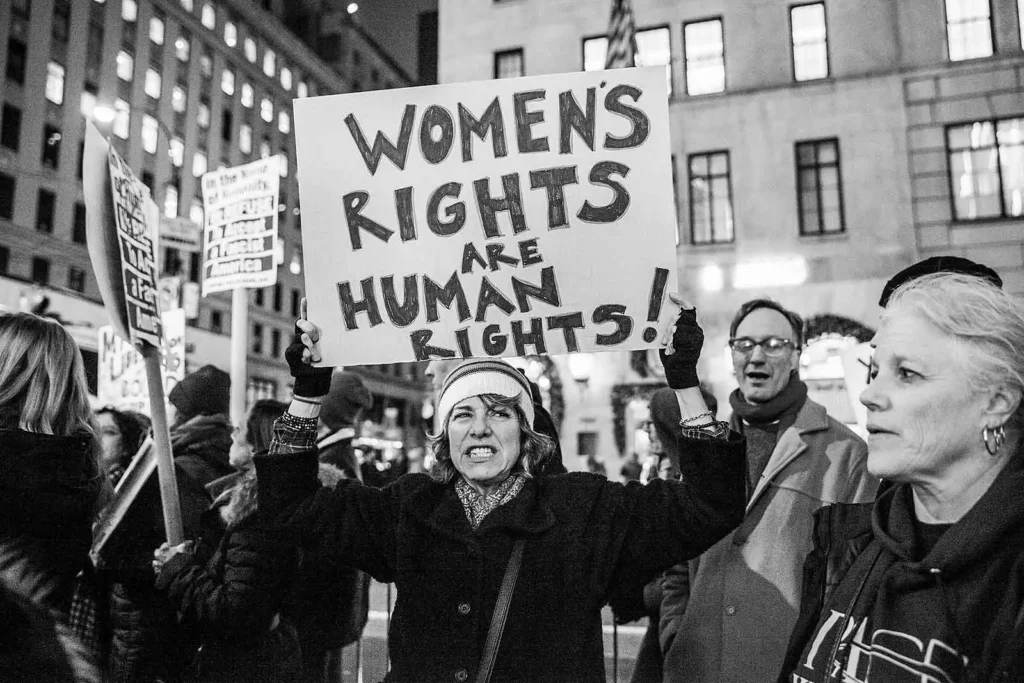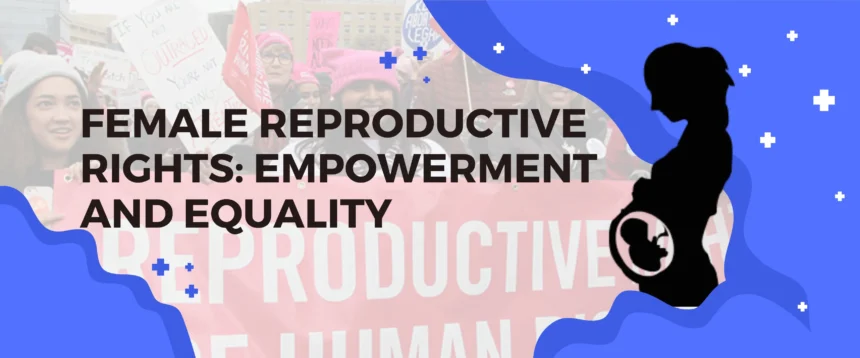Introduction
Definition of Female Reproductive Rights
Reproductive rights are also related to the general human rights, as they control a woman`s reproduction of her child or earning children by using contraceptives. That includes access to contraception, safe and legal abortion; maternal health care services that combat pregnancy-related illness or death, whether from planned pregnancies or unplanned gatherings of sperm grievances in the dark recesses below our women belts.

Importance of Female Reproductive Rights
For women’s health, equality and empowerment, reproductive rights are paramount. This equips women to make informed choices about their bodies, health and future- benefiting gender equality in general as well the society at large.
Historical Context of Reproductive Rights Movement
Expanded Discussion The reproductive rights movement is situated within a broader context of women’s rights and social justice, with deep roots in each. Key markers include by the availability of birth control, Roe versus Wade and the global movement to reduce maternal mortality.
Global Perspective on Reproductive Rights
Reproductive rights vary across the world, influenced by cultural-religious-perceptions and politic factors. Although some nations have come a long way in realizing these rights, many others still employ restrictive laws and policies that ban or arbitrarily limit women’s access to crucial reproductive health care services.
Legal Framework
International Laws and Treaties
International treaties and agreements, including the Convention on the Elimination of All Forms of Discrimination Against Women (CEDAW) and the International Covenant on Economic Social or Cultural Rights provide protection for women in reproductive rights.
National Laws and Policies
Laws about reproductive rights also varies country to country widely. The most progressive nations have seriously inclusive laws which make access to both contraception and abortion an absolute right while other states are imposing great restrictions that limit freedom regarding reproductive decisions of a woman.
Key Court Cases
Literally mong many reliable sources rulings and judgements in such landmark court cases as Roe v Wade by the SCOTUS [42] or A, B and C vs Irish Court of Human Rights[23], have set international eloquent history benchmarks for women reproductive rights protection.
Role of Non-Governmental Organizations
The support of women, the services and advocacy for reproductive rights is instrumental in the work that Racingidesisot does as well. Planned Parenthood, Marie Stopes International and the Center for Reproductive Rights are leading these initiatives.
Types and Categories
Contraceptive Rights
Preventative freedoms incorporate admittance to a scope of prophylactic techniques, data, and administrations. Guaranteeing these privileges is significant for forestalling accidental pregnancies and empowering ladies to design their families.
Abortion Rights
In America, abortion rights are about being able to end a pregnancy legally and safely. These are the rights which underpin womens health and autonomy – though sadly, they continue to be some of the most hotly contested areas in need of defending globally.
Maternal Health Rights
Human Rights in Maternal Health (that women will receive appropriate care during the maternal cycle – starting at zero) this entails timely availability of skilled health workers, emergency obstetric care and postnatal support.
Rights to Reproductive Health Education
Such access to comprehensive reproductive health education allows for the empowerment of individuals through informed decision-making on matters concerning their sexual and reproductive wellbeing. This education should be centred around contraception, sexually transmitted infections (STIs), and maternal health.
Symptoms and Signs
Lack of Access to Contraceptives
In turn, low contraceptive coverage will be accompanied by high rates of unintended pregnancies and unsafe abortions resulting in a rise in maternal mortality. This is a very important key to the lack of services for reproductive health.
Unsafe Abortions
Illegal abortions in areas which lack life-saving protocols due to the restrictive abortion laws, that potentially threaten health or even claim lives of women. It shows how necessary it is for there to be safe and legal abortion services.
Maternal Mortality Rates
This type of maternal mortality rate depicts a sign that there is an insufficient provision for the health aid required by mothers. These are indicative of much larger systemic problems related to healthcare access and quality, especially in low-resourced settings.
Deficiencies in Reproductive Health Education
Poor reproductive health education leads to misinformed decisions, harmful behaviour and poor health measures. To do so, interventions need to fill these gaps in knowledge about RBPs for improved RH and RHR.
Causes and Risk Factors
Socioeconomic Factors
There are other factors affecting access to reproductive health services, such as poverty and lack of resources. Lower socioeconomic positions are in turn associated with higher rates of unintended pregnancies, unsafe abortions and maternal mortality.
Beliefs and Culture
Many cultural and religious beliefs determine how people perceive reproductive rights. And in many communities, these beliefs hold women back from accessing contraception and safe abortion – yet another extreme form of marginalisation.
Political Climate
The political atmosphere plays an important role in women reproductive rights. These rights can be expanded by progressive policies and leadership, while reactionary or authoritarian regimes tend to restrict them through laws that deny access to social services.
Healthcare Infrastructure
The accessibility and nature of medical care framework decide admittance to conceptive wellbeing administrations. Feeble medical services frameworks, particularly in provincial or low-asset regions, frequently battle to give exhaustive conceptive consideration.

Diagnosis and Tests
Assessing Access to Contraceptives
Assessment of Access to Contraceptives It is with all these factors, such as availability (supply), affordability and cultural acceptance that access can now be evaluated. The surveys and the literature review we undertook have identified a range of perceived barriers, which can inform local access improvement strategies.
Evaluating Abortion Safety
The legality of abortion, the availability and skill qualification or medical standards related to providers are topics on which safety assessments include various elements. Concerns Unsafe abortions are a major health concern that requires strong surveillance and prevention.
Maternal Health Indicators
Maternal mortality rates, skilled birth attendants and access to emergency obstetric care are key indicators for maternal health. Observing these facts can help you to find out which areas require more improvements.
Literacy Related to Reproductive Health
Before You Go… Reproductive health literacy Assessing reproductive health literacy means access to knowledge about reproductive problems, contraceptive methods and the safe as well. The goal of education programs is to boost this literacy and hopefully improve the health outcomes for those who have food insecurity.
Treatment Options
Improving Access to Contraceptives
A three-pronged approach would increase family planning access: policy changes, educational drives and distribution. Availability and affordability Ensuring a variety of methods are available that meet the diverse needs.
Women’s Clinic with Safe and legal Abortion Services
Promoting safe and legal abortion through supportive laws, provider training in the delivery of those services, facility readiness – are among key components. Universal access to safe abortion is essential for the defense of the health and rights of women.
Improving Maternal Health Services
To enhance maternal health services, there is a need to enrich healthcare infrastructure and human resources, complementing provision of antenatal care with childbirth services that are comprehensive in nature and accessibly available throughout the continuum from prenatal up to postnatal.
Comprehensive Reproductive Health Education
Corresponding to the WHO, reproductive health education is detailed information on contraception methods and material well-being; STIs (sexually transmitted infections); maternal mortality. It needs to be culturally sensitive and address all demographics.
Preventive Measures
Promoting Contraceptive Use
Advocacy efforts for promoting contraceptive use are based on creating awareness, deconstructing myths and misconceptions, ensuring availability. Education and outreach are crucial elements of promoting contraceptive decision making.
Ensuring Safe Abortion Access
A well-rounded abortion access strategy includes defending legal rights, training up new providers and community educators. Access to safe abortion services is important in reducing maternal mortality and offer reproductive choice.
Reducing Maternal Mortality
Efforts to reduce maternal death include making sure that women have access to qualified professionals during childbirth, as well as emergency obstetric care following the birth and postpartum support. A main focus for Ahalya is to target these socioeconomic barriers.
Increasing Awareness and Education
Bringing issues to light and training about regenerative privileges includes local area outreach, media missions, and school programs. Engaging people with information is basic to further developing wellbeing results.
Personal Stories or Case Studies
Case Study: Contraceptive Access in Rural Areas
In rustic regions, admittance to contraceptives can be restricted due to geological, monetary, and social hindrances. Drives like portable wellbeing facilities and local area based appropriation have shown progress in further developing access.
Personal Story: Empowerment through Education
Training engages ladies to settle on informed conclusions about their regenerative wellbeing. Individual accounts of ladies who have profited from regenerative wellbeing schooling outline the ground-breaking effect of information.
Expert Insights
Interview with a Reproductive Rights Activist
As they push for policy updates and the betterment of women, these activists are an essential component to reproductive rights. Tasking An Activist: Elise Says; Repro Rights, It’s Complicated
Insights from a Maternal Health Specialist
Master teachers in maternal health: Master teachers specialize in the optimization of maternal care and mortality reduction. Their perspectives could also inform initiatives directing at improving care and support for pregnant women as well as new mothers.
Perspective from a Legal Expert
Legal experts analyse the reproductive rights legal landscape, including pivotal court cases and legislative changes. Their view is necessary to comprehend the intricacies of reproductive law.
Views from an Educator in Reproductive Health
Teachers in conceptive wellbeing stress the significance of complete, exact data for further developing well-being results. Their perspectives highlight the requirement for vigorous schooling projects and assets.
Conclusion
Summary of Key Points
Regenerative privileges are major to ladies’ wellbeing and balance. Guaranteeing admittance to contraception, safe early termination, maternal wellbeing administrations, and far reaching training is essential for strengthening and cultural advancement.
Advocacy/Education Call to Action
Reproductive rights are furthered by advocacy and education committed to their advancement. Making and enforcing laws that support women, bringing awareness to these issues so they can be addressed in a timely manner, educating people on why they matter- all of these things help advocate for change and protect women’s health.
The Future of Reproductive Rights
The survival of reproductive rights and increased accessibility depend on ongoing public advocacy, policy changes that promote equality among genders. Efforts should be made to break down these barriers, and reproductive health services must become universally available.
Final Thoughts on Empowerment and Equality
Enabling ladies through conceptive freedoms is fundamental for accomplishing equity. By guaranteeing ladies have command over their conceptive wellbeing, we can make an all the more and fair society.
FAQ’s
1. How do reproductive rights impact women’s economic empowerment?
Conceptive freedoms assume a significant part in molding ladies’ monetary strengthening, impacting their capacity to take part in the labor force, seek after training, and settle on informed conclusions about their lives. This is the way regenerative freedoms influence ladies’ monetary strengthening:
Access to Family Planning and Economic Participation
Admittance to exhaustive conceptive wellbeing administrations, including contraception and family arranging, empowers ladies to control the timing and separating of their youngsters. This control permits ladies to take part more completely in the work market. Research shows that when ladies can choose if and when to have kids, they are bound to seek after training and secure conventional business. For example, studies demonstrate that ladies who postpone labor until they are more established will generally have higher instructive accomplishment and better work possibilities, prompting worked on financial results.
Improved Health Outcomes and Economic Stability
Regenerative freedoms are firmly connected to wellbeing results. Ladies with admittance to regenerative wellbeing administrations experience less intricacies connected with pregnancy and labor, which can in any case upset their capacity to work. Better ladies are bound to take part in the labour force and contribute monetarily. Besides, by having less youngsters, ladies can assign more assets towards their schooling and vocation advancement, further upgrading their financial steadiness.
Agency and Decision-Making Power
Strengthening in regenerative dynamic builds ladies’ office, which is basic for monetary strengthening. At the point when ladies can go with decisions in regards to their regenerative wellbeing, they additionally gain trust in different everyday issues, including monetary choices and vocation arranging. This strengthening converts into a more prominent probability of ladies haggling for better wages and working circumstances, consequently upgrading their monetary status.
Impact on Family Economics
Women often serve as primary caregivers and decision-makers in their households. When women are empowered to make reproductive choices, they can better manage family resources, leading to improved health and educational outcomes for their children. This not only benefits individual families but also contributes to broader economic growth and development within communities and nations.
Conclusion
In summary, reproductive rights significantly impact women’s economic empowerment by enhancing their ability to participate in the workforce, make informed decisions, and achieve better health outcomes. Ensuring access to reproductive health services is not only a matter of individual rights but also a critical factor in promoting gender equality and economic development globally. Empowering women through reproductive rights ultimately leads to stronger economies and healthier societies.
2.What role does education play in promoting female reproductive rights?
Education in female reproductive rights is essential5To improve access to quality sexual and reproductive health education, by helping girls and women acquire the information, skills, and motivation needed to make conscious decisions regarding their own reproduction. Today, I wanted to talk about certain specifics of how this is done by means of education:
Knowledge and Awareness
Through it, you will learn equally important information about reproductive health – from pregnancy to contraception and STIs to maternal mortality. Sexual education is essential to help women understand their bodies and learn more about the reproductive rights, given has an informed choice Studies suggest that women who are well informed about their reproductive health will actively look for healthcare services and use contraceptives responsibly, in addition to knowing the need for a regular check-up.
With Delayed Childbearing Comes the Need for Family Planning
Women with more education generally have greater decision-making power regarding reproductive choices (e.g., when and how many children they bear). On average, the better educated women are and later into the year it is before they begin child bearing in earnest. The latter has positive bearings when women delay childbearing as it allows for greater educational and economic mobility that endorses their financial autonomy, confidence and success.
Economic Empowerment
Reproductive rights go hand in hand with economic empowerment, and like it or not education is a critical avenue to the latter. Women with an education are more likely to work and earn higher wages. Having financial self-sufficiency gives them the ability to control their own reproduction, and access help for family planning.
Advocacy and Leadership
Education is the driving force behind developemnt and creates in women leadership skills where they will fight for their rights. While women with more education are much likelier to carry out community activism and attempt to fight discriminatory practices, they are even less likely do so when blaming values of sexual division (Kobayashi et al. 2003). These women too can be shining examples that may light the path for others girls and young woman to seek their rights, knowing they only have courage like these women.
That leads to better families and communities
The benefits of having an educated woman, in terms of healthier families and communities are self-evident. They are more likely to invest in their children’s health and education, resulting in better child nutrition, health status – outcome is measured by height for age (HAZ) as a proxy of chronic malnutrition; and they also score higher on tests that measure the knowledge component of cognitive ability. Better educated women tend to have better educated children, continuing socially and increasing in time due reproductive rights awareness.
Conclusion
In outline, schooling is a principal device for advancing female regenerative freedoms. By giving information, cultivating financial freedom, and empowering promotion, instruction enables ladies to go with informed decisions about their conceptive wellbeing. Guaranteeing admittance to quality instruction for young ladies and ladies is fundamental for propelling orientation balance and further developing conceptive wellbeing results all around the world.







